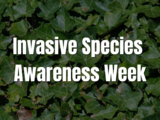Invasive Species Awareness Week
Help stop the spread of invasive species!
February 22 through the 28th is National Invasive Species Awareness Week! Invasive species are a problem around the world, in Maryland, and specifically an issue on our campus.
What is an invasive species?
An invasive species is an organism that causes ecological or economic harm in a new environment where it is not native. Invasive plants out-compete and eliminate native species resulting in negative ecological changes. Invasive species are one of the many threats to biodiversity on our planet.
Below are few common invasive species that threaten Maryland’s diverse ecosystem:
Emerald Ash Borer:

These beetles originated from Asia and were first discovered in Michigan. They are now all along the Eastern United States. They burrow and kill native ash trees. Since its arrival in Maryland, Emerald Ash Borers have killed thousands of native ash trees.
Blue and flathead catfish:

Native to the Mississippi, Missouri and Ohio River basins, blue catfish were introduced to the James, Rappahannock and York rivers in the 1970s as a recreational catch. Both blue and flathead catfish have a long lifespan and an expansive diet. The rapid expansion of these fish have raised concerns about the health of native species in the bay. Our office and Chartwells have partnered the past two years to create meals in the dining halls with these fish to slow down their overpopulation in the region!
English Ivy:

European colonists introduced English ivy as early as 1727. English ivy is an aggressive invader that threatens all vegetation levels of forested and open areas, growing along the ground as well as into the forest canopy. Vines climb and cover trees, starving them of sunlight, causing branch and eventual tree death.
Tree-of-Heaven:

Tree-of-heaven is a native to China, and was introduced by English colonists as an exotic, fast growing, ornamental shade tree. This invasive plant produces an overly abundant amount of seeds, crowds out native species with its dense thickets and secretes a chemical into the soil that is toxic to surrounding plants.
Check out University of Maryland Extension for an extensive list of invasive plant species in Maryland!
What can you do?:
- Make sure to plant native species in your garden
- Always thoroughly clean your hiking equipment and boots before leaving an area to prevent the spread
- Learn to identify and remove invasives properly.
- Once we are back on campus join our very own Environmental Task Force on Friday clean-ups to remove invasives!
Posted: February 23, 2021, 10:39 AM
